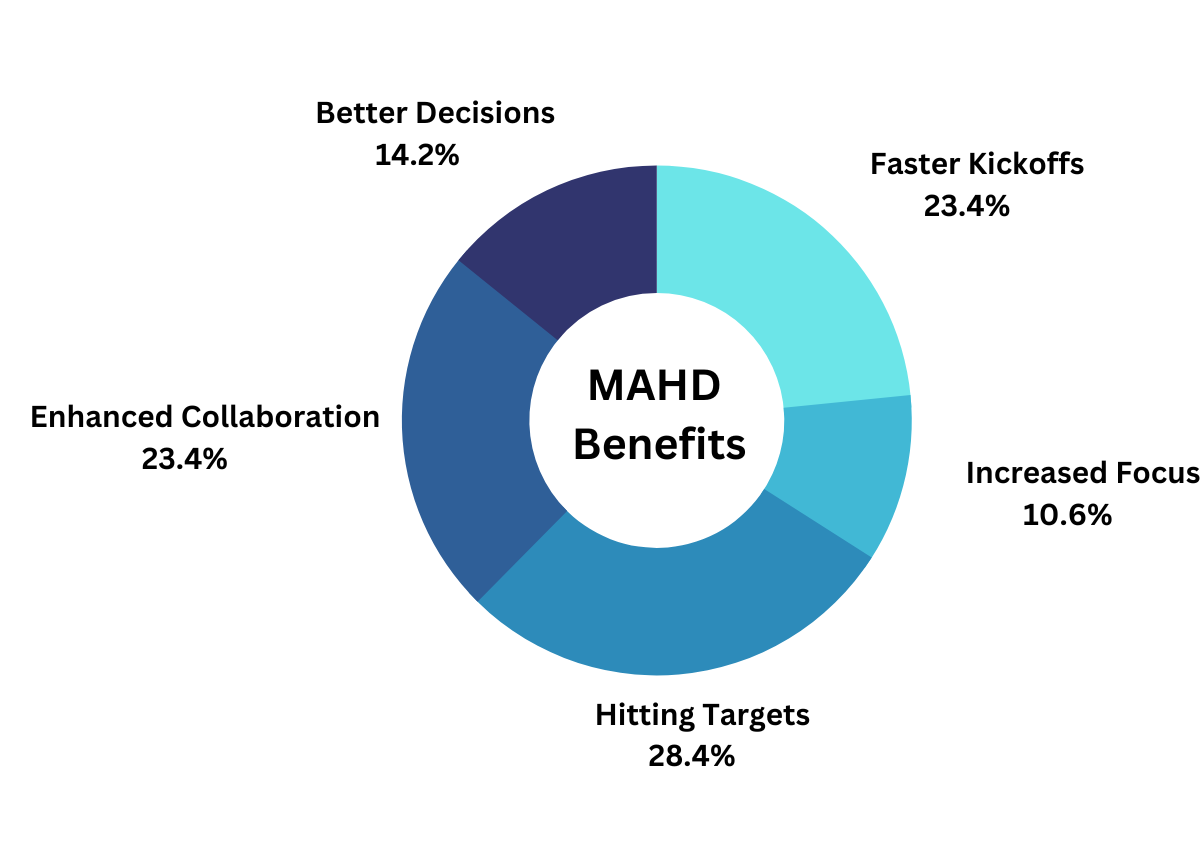The MAHD Framework has been implemented by leading product development companies in over 20 countries (and counting) and in product categories ranging from electronic toys to defense contractors.
In each case they are using agile methods based on the MAHD Framework to develop products faster, manage changing requirements and increasing their focus on delivering customer value. Other benefits companies see include:

MAHD IPAC Iterations deliver a clear understanding of tangible project progress through demonstrated prototype functionality and feedback with throughout the development process.
The MAHD Framework starts with collaboration among team members to identify critical project elements, such as customer needs, risk, innovation, schedule, targets, and resources. Collaboration continues on a regular basis to ensure that the project remains on track.
The MAHD On-ramp results in a comprehensive view of the project in a fraction of the time typical of traditional processes. Teams start with an aligned Iteration Plan ready for execution.

With a consistent focus on demonstrable progress and learning through customer feedback and technical evaluation loops, data is gathered early for faster and better resource/scope/schedule tradeoff decisions.
At its core, the MAHD Framework emphasizes early and consistent focus on resolving unknowns, prioritizing customer value, and leveraging rapid learning and execution to mitigate both technical and commercial risks.
Since 2017, the MAHD Framework has helped teams go on average 25% to 50% faster, with reduced risk and higher customer value.

Investing in process improvement should drive measurable business results. Based on experience and customer feedback, the MAHD Framework consistently accelerates time-to-market—delivering solutions, on average, 25% faster—while increasing customer value and reducing costs. This yields significant financial benefits to organizations by:
To estimate how the ROI of your projects can be improved with the MAHD Framework, use our Project ROI Estimator to compare results of traditional methods vs a MAHD approach.
Waterfall processes have been around for decades, and about 80% of companies use some form of phase-gate NPD process. These processes provide an overall governance structure but little guidance on how to manage an effective way of working. Rigid project management tools attempt to fill the gaps, but most teams find they hinder rather than improve efforts. Some of the top challenges with waterfall processes include:
Agile methods and the MAHD Framework can help with each of these challenges. Browse the 10 Benefits of MAHD Vs. Traditional NPD to learn more.
Most development teams struggle with waterfall methods, but software teams had it the worst. They were asked to follow rigid processes like Stage-gate, which required extensive requirements gathering and documentation. Teams rightly questioned the point of spending months documenting your plan when you can start coding, learn, add features incrementally, and test with real users to get feedback? Waterfall just doesn’t make sense for software. Agile’s learning cycles, team orientation, and backlog prioritization methods are a much better fit and why adoption of agile has been so rapid.
Agile is nearly ubiquitous with software teams, but hardware teams have been slow to adopt it. One reason is that hardware leaders and executives find it difficult to visualize how agile tactics can work for hardware. Another reason is that companies saw success with their software teams and relied on the same coaches and scrum masters to train their hardware teams, but these trainers often had no real hardware experience. This major gap in both the tactics taught and the skillset of the trainers left many hardware teams struggling to see the value in agile and even the point of changing.
The companies who have expended the time and energy to truly understand the agile mindset and adapt the tactics to their needs are having tremendous success with agile methods. Some are just beginning their Agile journey with the MAHD Framework and others have matured to consistently better results over previous methods.
Teams who focus on the core Agile principles and modify their behavior and ways-of-working to build on these principles will be successful. Those who are trying to fit the Agile software tactics into an existing NPD framework will not. The principles are sound, but tactics of Agile must be modified whether you apply the MAHD Framework or design your own.
Agile was not conceived or defined with hardware in mind. As a result, the benefits of Agile are less obvious for physical products, and attempting to implement Agile without modifications can be unproductive at best and even disastrous. However, hardware-based product development can get big benefits with agile.
To make it work, teams must abandon what they think they know about agile and look at the principles with a fresh perspective. They must be comfortable initiating a project without detailed requirements, actively collaborate with their colleagues, consider rapid prototyping as possible and necessary, and acknowledge that customers need to experience solutions to provide meaningful feedback.
Once this mindshift happens, the tactics are easy and the benefits follow quickly.
There are unlimited research articles that support agile methods are superior to traditional waterfall approaches. While data is still difficult to come by for organizations transitioning to MAHD or other agile for hardware approaches, we believe the data that is available is compelling. So why don’t more hardware teams adopt agile method?
The objections to adopting Agile for hardware we often hear:
These try to apply Scrum or other Agile for SW directly to hardware development. Because most people directly associate the tactics of Agile they are familiar with, such as Scrum, directly to hardware, these objections are well-founded.
However, each of these objections are easily addressed with the right tactics. It’s desirable and possible to maintain and hit schedules; there is no need to develop a working prototype every iteration; agile tactics can be developed to manage lead times, consider solutions holistically, etc. These are all tactics that are part of the MAHD Framework to get the benefits of Agile, while meeting the needs of hardware development.
To discover how the MAHD Framework can accelerate your NPD efforts, download the Intro to MAHD e-book or contact us to discuss your needs.
Download the comprehensive Introduction to MAHD E-book to learn about the key elements of the MAHD Framework.
Request a 45-minute overview and discussion of your situation. We can provide an overview of the MAHD Framework and help you determine if MAHD is a good fit for your goals.
Going MAHD Newsletter
Get the latest articles and resources delivered directly to your email.
© 2023 MAHD Framework, LLC